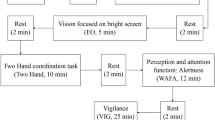Abstract
Electroencephalogram (EEG) is a research subject that has been studied constantly. By the analysis of EEG signals, the mental state of the humans can be detected, so it would contribute to the design of human-machine interaction (HMI) systems. In this paper, we intend to study the cognitive state using EEG signals when the subject is performing a visual search task. We tried to obtain the different patterns of the EEG signals when the subject is performing differently in the task. Several pattern recognition algorithms on the signal are conducted to find the principal features in the EEG signals. We can see that the features of EEG signals can present the differences between cognitive states and this result will be beneficial to the recognition of the cognitive state of the operators in the complex systems.
Access this chapter
Tax calculation will be finalised at checkout
Purchases are for personal use only
Similar content being viewed by others
References
Proctor, R.W., Van Zandt, T.: Human Factors in Simple and Complex Systems. Allyn & Bacon, Needham Heights (1994)
Wang, X.-W., Nie, D., Lu, B.-L.: EEG-based emotion recognition using frequency domain features and support vector machines (2011). Source: DBLP. https://doi.org/10.1007/978-3-642-24955-6_87
Black, M., Yacoob, Y.: Recognizing facial expressions in image sequences using local parameterized models of image motion. Int. J. Comput. Vision 25(1), 23–48 (1997)
Petrushin, V.: Emotion in speech: recognition and application to call centers. In: Proceedings of Artificial Neural Networks in Engineering, pp. 7–10 (1999)
Zeng, Z., Pantic, M., Roisman, G.I., Huang, T.S.: A survey of affect recognition methods: audio, visual and spontaneous expressions. In: Proceedings of the 9th International Conference on Multimodal Interfaces, ICME 2007, pp. 126–133 (2007)
Musha, T., Terasaki, Y., Haque, H., Ivamitsky, G.: Feature extraction from EEGs associated with emotions. Artif. Life Robot. 1(1), 15–19 (1997)
Frazier, T.W., Strauss, M.E., Steinhauer, S.R.: Respiratory sinus arrhythmia as an index of emotional response in young adults. Psychophysiology 41(1), 75–83 (2004)
Lang, P.J., Greenwald, M.K., Bradley, M.M., Hamm, A.O.: Looking at pictures: affective, facial, visceral, and behavioral reactions. Psychophysiology 30(3), 261–273 (1993)
Cacioppo, J.T., Petty, R.E., Losch, M.E., Kim, H.S.: Electromyographic activity over facial muscle regions can differentiate the valence and intensity of affective reactions. J. Pers. Soc. Psychol. 50(2), 260–268 (1986)
Magnée, M.J., Stekelenburg, J.J., Kemner, C., de Gelder, B.: Similar facial electromyographic responses to faces, voices, and body expressions. NeuroReport 18(4), 369–372 (2007)
Demaree, H.A., Everhart, E.D., Youngstrom, E.A., Harrison, D.W.: Brain lateralization of emotional processing: historical roots and a future incorporating dominance. Behav. Cogn. Neurosci. Rev. 4(1), 3–20 (2005)
Sanei, S., Chambers, J.: EEG Signal Processing. Wiley, New York (2007)
Schaaff, K., Schultz, T.: Towards emotion recognition from electroencephalographic signals. In: Proceedings of International Conference on Affective Computing and Intelligent Interaction, pp. 175–180, September 2009
Kim, M.-K., Kim, M., Oh, E., Kim, S.-P.: A review on the computational methods for emotional state estimation from the human EEG. Comput. Math. Methods Med. 2013, 1–13 (2013)
Jenke, R., Peer, A., Buss, M.: Feature extraction and selection for emotion recognition from EEG. IEEE Trans. Affect. Comput. 5(3), 327–339 (2014)
Duffy, F.H.: Brain electric activity mapping, a method for extending the clinical utility of EEG and evoked potential data. Ann. Neurol. (2011). https://doi.org/10.1002/ana.410050402
Author information
Authors and Affiliations
Corresponding author
Editor information
Editors and Affiliations
Rights and permissions
Copyright information
© 2020 Springer Nature Switzerland AG
About this paper
Cite this paper
Zhang, S., Lu, Y., Fu, S. (2020). Recognition of the Cognitive State in the Visual Search Task. In: Ayaz, H. (eds) Advances in Neuroergonomics and Cognitive Engineering. AHFE 2019. Advances in Intelligent Systems and Computing, vol 953. Springer, Cham. https://doi.org/10.1007/978-3-030-20473-0_35
Download citation
DOI: https://doi.org/10.1007/978-3-030-20473-0_35
Published:
Publisher Name: Springer, Cham
Print ISBN: 978-3-030-20472-3
Online ISBN: 978-3-030-20473-0
eBook Packages: Intelligent Technologies and RoboticsIntelligent Technologies and Robotics (R0)




